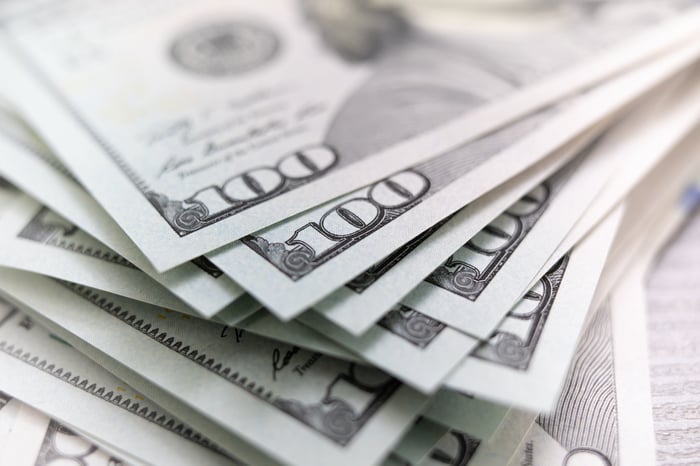It's been a record-breaking year for Wall Street in many respects. The CBOE Volatility Index reached its highest-ever reading, West Texas Intermediate crude futures plunged deeply (but briefly) into the negative, and the bear market declined and rebounded from a bear-market bottom at the fastest rate in history.
If 2020 has taught us anything, it's the value of long-term investing.

Image source: Getty Images.
One exceptionally successful investor who's taken long-term investing to heart is Berkshire Hathaway (BRK.A -0.39%) (BRK.B -0.35%) CEO Warren Buffett. Over the past 55 years, Buffett's company has returned more than 2,700,000% for its shareholders, in aggregate, with much of these gains realized from the Oracle of Omaha buying great companies and hanging onto them over long periods of time.
Buffett has a knack for finding well-run companies with visible brands and clear-cut competitive advantages. Given his track record of success, when one of Buffett's close to four-dozen investment holdings pulls back, it gets a lot of attention on Wall Street and within the investment community.
Right now, there are three Buffett stocks that look like screaming buys. If you have $2,000 in disposable cash you don't need for bills or emergencies, consider putting that money to work in the following three stocks.

Image source: Getty Images.
Wells Fargo
Even though it's a stock that Buffett has been selling over the past two years, longtime holding Wells Fargo (WFC 0.75%) has all the hallmarks of a turnaround play for patient long-term investors.
Wells Fargo has been hit on all fronts. The Federal Reserve has reduced its federal funds rate back to a record-tying low, which is constraining Wells Fargo's ability to earn interest income. It's also expected to see an increase in loan delinquencies and charge-offs tied to the coronavirus disease 2019 (COVID-19) recession. As the icing on the cake, the company is paying its penance for opening 3.5 million unauthorized accounts between 2009 and 2016.
But for all of these issues, Wells Fargo's foundation remains intact. This is a company with a rich history of delivering superior returns on assets. This success is based on the company's ability to lure affluent clientele. These well-to-do customers are less likely to change their spending habits or default on their loans during periods of economic stress, and are more likely to take advantage of multiple financial services, such as asset management or home loans.
Additionally, Wells Fargo has delivered steady progress on the technological front. It ended September with 32 million online and mobile active customers, up 6% from the prior-year period. Digital transactions are significantly cheaper for the company than in-person or phone interactions. The more users go digital, the easier it'll be for Wells Fargo to consolidate some of its branches and reduce its noninterest expenses.
As of Oct. 23, Wells Fargo was valued at 60% of its book value, which is about as inexpensive as this company has been in well over three decades, save for one week at the height of the financial crisis. It's a good bet to bounce back this decade and makes for a screaming buy.

Image source: Getty Images.
Barrick Gold
Though gold is often thought of as nothing more than a hedge, the time is ripe for investors to buy into high-quality gold stocks. That's why Berkshire Hathaway holding Barrick Gold (GOLD 0.26%) should be on your buy list.
The Barrick Gold buy thesis can be broken down into macroeconomic factors and company-specific measures. On a macro basis, I've never seen more catalysts in the sails for gold in my more than two decades of investing. Global bond yields have cratered, and the Fed has made clear that it wants to keep lending rates low for at least the next couple of years. Without avenues for income seekers to generate inflation-topping returns, look for them to purchase gold as a store of value.
Furthermore, the Fed's willingness to utilize unlimited quantitative easing measures to calm U.S. financial markets has ballooned the money supply. This should continue to pressure the U.S. dollar, which has an inverse relationship with gold. In short, Barrick Gold is going to benefit from a higher physical gold price.
On a more company-specific level, Barrick Gold has done an excellent job of improving its balance sheet. Net debt fell almost 25% during the June-ended quarter to $1.4 billion, and the company isn't facing any significant debt maturities for 13 more years. Barrick has jettisoned $1.5 billion in noncore assets, and has seen a huge uptick in free cash flow as realized gold prices have soared and the company has improved the operating efficiency of core producing assets.
Having followed the gold-mining industry for the past 15 years, I've found a multiple of 10 times operating cash flow to be a fair valuation. Barrick is currently valued at about 20% below a 10-time multiple for 2021, with plenty of opportunity for cash-flow expansion as gold prices climb.

Image source: Getty Images.
Amazon
Finally, there's Amazon (AMZN 3.15%) -- a screaming buy that can be purchased hand over fist as a foundational holding for investors' portfolios.
Whereas most retailers have been negatively impacted by the COVID-19 pandemic, Amazon has thrived. The company is best known for its e-commerce presence. Sources vary, but it's estimated that Amazon controls between 37% and 44% of all online sales in the U.S., and is somewhere around 33 percentage points to 37 percentage points above its next closest competitor. When the pandemic hit and consumers were urged to stay at home as much as possible, Amazon became exceptionally popular.
The downside of retail is that margins associated with Amazon's marketplace aren't all that great. Nevertheless, Amazon has been able to pivot its popularity into signing up over 150 million people to Prime memberships. The fees collected from these memberships help it undercut brick-and-mortar retailers on price and keep consumers loyal to the Amazon brand.
But over the long run, Amazon's cloud-infrastructure segment, Amazon Web Services, will act as the company's core growth driver. Even though AWS has only accounted for 12.8% of total sales through the first six months of 2020, the segment is responsible for $6.43 billion of Amazon's $9.83 billion in operating income. Since cloud margins are light-years higher than retail margins, AWS can pack a much bigger punch as it grows into a larger percentage of total sales.
With Wall Street estimating that Amazon's operating cash flow can nearly triple between 2019 and 2023, and the company currently valued at 16 times 2023's estimated cash flow -- Amazon had a median multiple of 30 times operating cash flow last decade -- it looks like a screaming buy.





